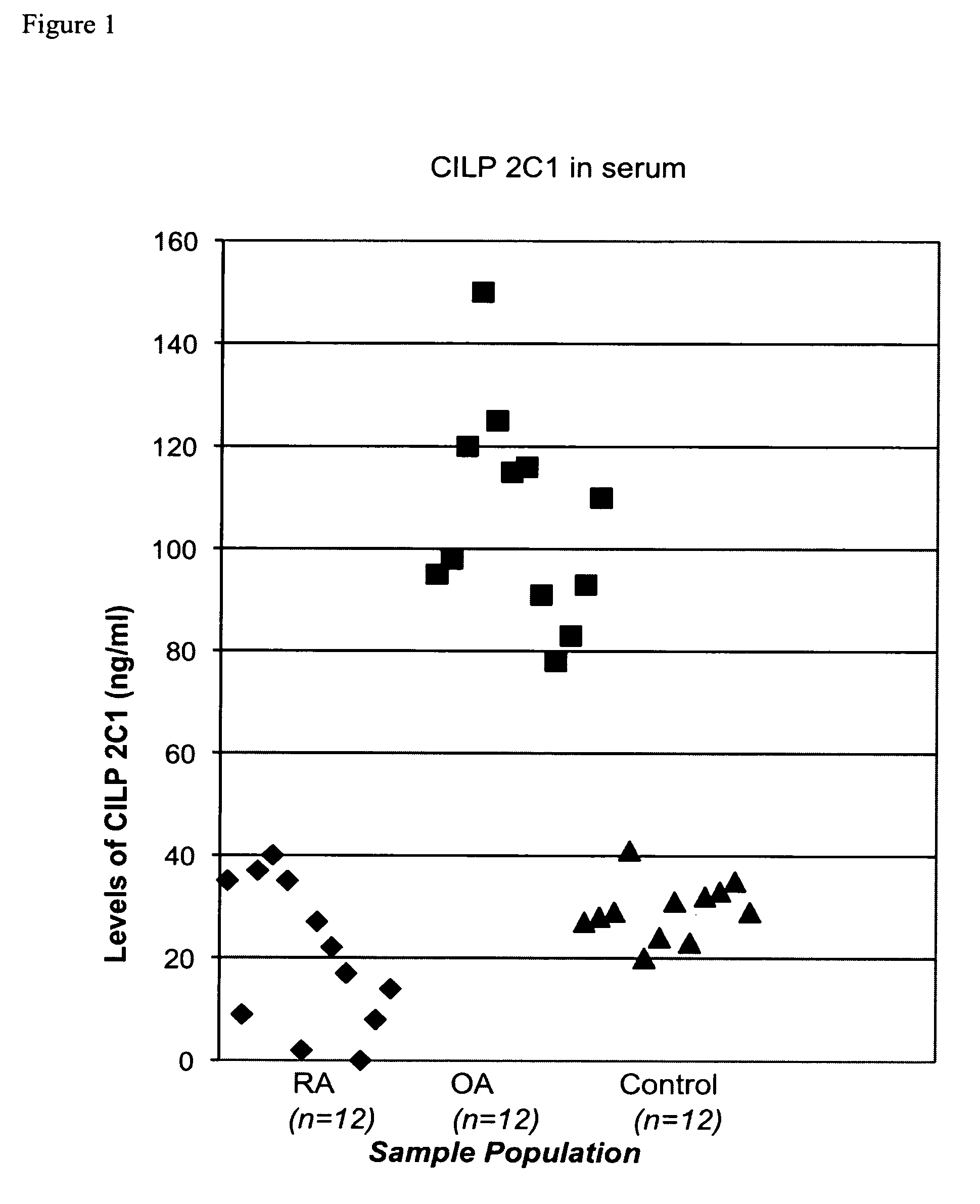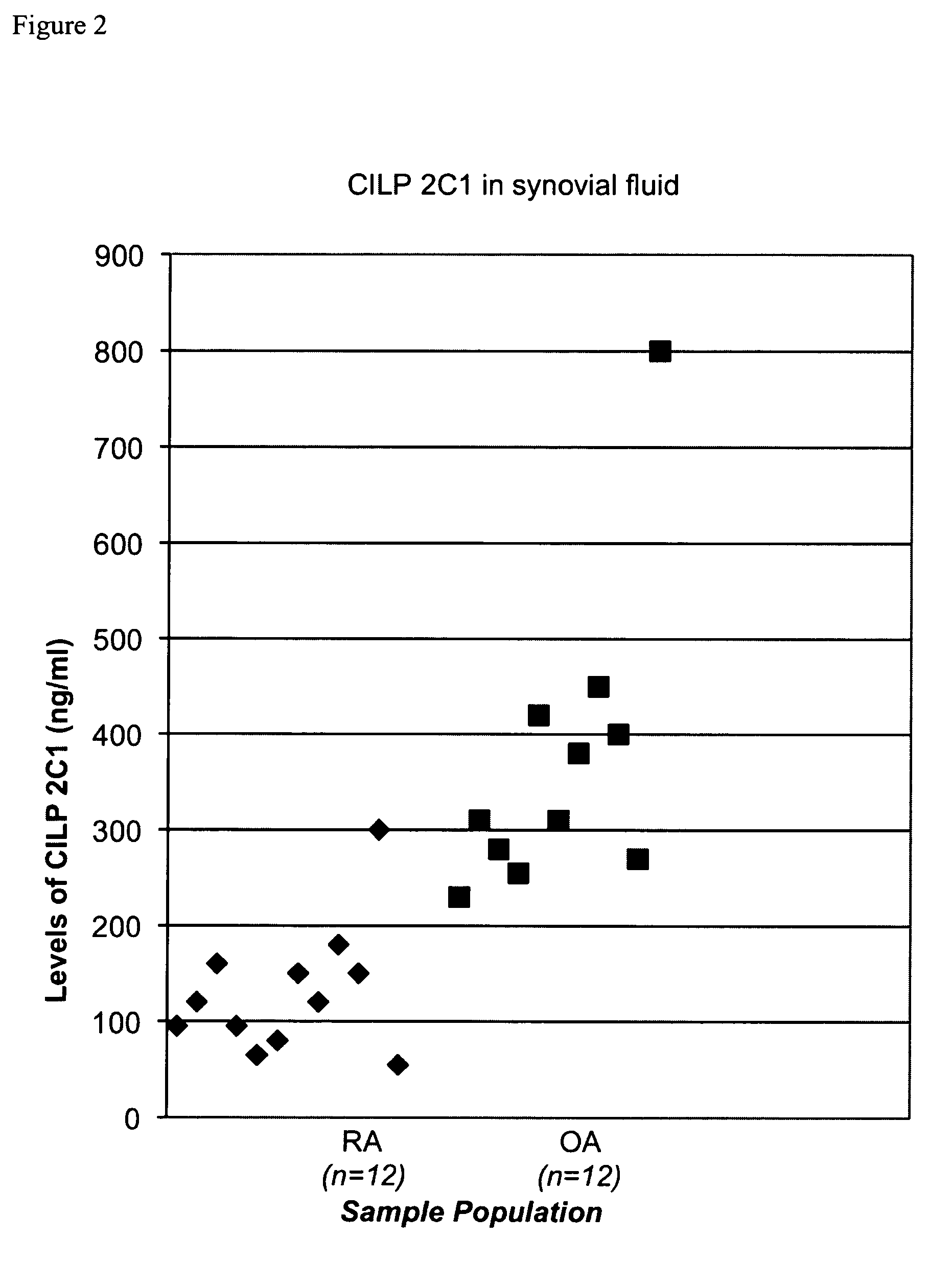Cartilage intermediate layer protein 2 C1 and its use to differentiate osteoarthritis from rheumatoid arthritis and non-disease conditions
a technology of cartilage intermediate layer and protein, which is applied in the direction of instruments, peptides/protein ingredients, peptides, etc., can solve the problems of joint deformation, limiting movement, and accompanied by muscle weakness or deterioration
- Summary
- Abstract
- Description
- Claims
- Application Information
AI Technical Summary
Benefits of technology
Problems solved by technology
Method used
Image
Examples
example 1
Preparation of the Antigen and Antiserum
[0040]A synthetic peptide within the amino acids 21-709 (SEQ ID NO: 1), of the human CILP-2 (GeneBank accession nr. Q8IUL8) was used as immunogen. An additional cysteine residue was added at the amino termini to allow selective coupling to different substrates. The peptide sequence (SEQ ID NO: 1) was used as immunogen after conjugation in its N-terminal via an added cysteine to keyhole limpet hemocyanin (KLH) for the production of polyclonal antibodies according to standard protocols. Any fragment in the range of amino acids 21-709, of the human cartilage intermediate layer protein 2 C1 could be used as an immunogen.
[0041]A commercial source (Innovagen AB, Lund, Sweden) was used for the synthesis of the peptide, the conjugation to a carrier, the preparation of the antigen for immunization, including the injection to the rabbit and the production of the antiserum.
example 2
Purification of the Anti Peptide Antibody from the Crude Antiserum
[0042]The generated antiserum was affinity purified on a column with the immobilized cartilage intermediate layer protein 2 C1 peptide, (Innovagen AB, Lund, Sweden). The column (1.5 ml gel) was equilibrated with phosphate buffered saline (PBS, 0.1 M phosphate buffer, 150 mM NaCl, pH 7.5) and 5 ml of serum were applied and incubated end over end for 1 hour at room temperature then further incubated for 1 hour without mixing. The column was washed with 15 and then with 10 ml PBS containing 1 M NaCl. The column was eluted step wise with 1.5 ml of 100 mM Glycine pH 2.7. Ten fractions were collected and neutralized immediately with 50 μl of 1M Tris pH 9.5. Fractions with the highest absorbance were pooled and dialyzed against PBS containing 0.05% sodium azide. After dialysis the volume was measured and the concentration of the IgG was determined by it OD at 280 nm. The affinity purified antibody, stored frozen at −20° C. i...
example 3
Competitive Enzyme Linked Immunosorbent Assay (ELISA) for Cartilage Intermediate Layer Protein 2 C1
[0043]A specific competitive ELISA was developed to measure human cartilage intermediate layer 2 C1 in body fluids.
[0044]1. Biotinylation of the peptides: Peptides were biotinylated via their terminal cysteine with EZ-Link®Maleimide PEO2-Biotin as described by the manufacturer (PIERCE).
[0045]2. Pre-treatment of the antibody: The affinity purified peptide antibody was diluted 1:50 in phosphate buffered saline (PBS), pH 7.4 containing 5% n,n-dimethylformamide (Sigma-Aldrich). After incubation for 1 hour at room temperature the antibody was diluted to 1:2000 with 4% Triton in 10 mM phosphate (NaH2PO4) pH 7.5.
[0046]3. Pre-treatment of the standard and samples: Standard (from 1 to 125 ng / ml) in 1% (w / v) sodium dodecyl benzene sulfonate (SDBS, Sigma-Aldrich) in 0.1 M sodium chloride, 0.05 M sodium phosphate pH 7.5 containing 0.5% bovine serum albumin (BSA, Sigma-Aldrich) and an appropriate d...
PUM
| Property | Measurement | Unit |
|---|---|---|
| time | aaaaa | aaaaa |
| pH | aaaaa | aaaaa |
| pH | aaaaa | aaaaa |
Abstract
Description
Claims
Application Information
 Login to View More
Login to View More - R&D Engineer
- R&D Manager
- IP Professional
- Industry Leading Data Capabilities
- Powerful AI technology
- Patent DNA Extraction
Browse by: Latest US Patents, China's latest patents, Technical Efficacy Thesaurus, Application Domain, Technology Topic, Popular Technical Reports.
© 2024 PatSnap. All rights reserved.Legal|Privacy policy|Modern Slavery Act Transparency Statement|Sitemap|About US| Contact US: help@patsnap.com









